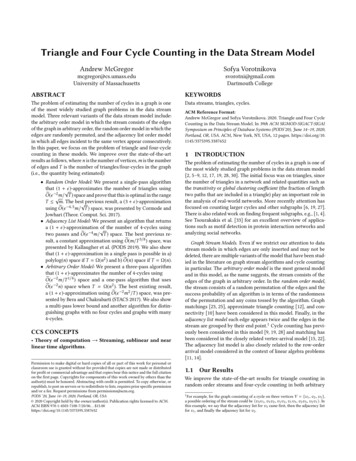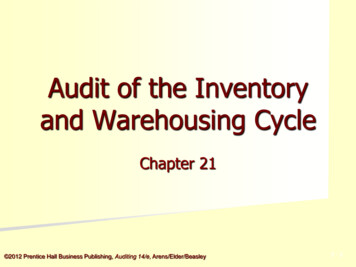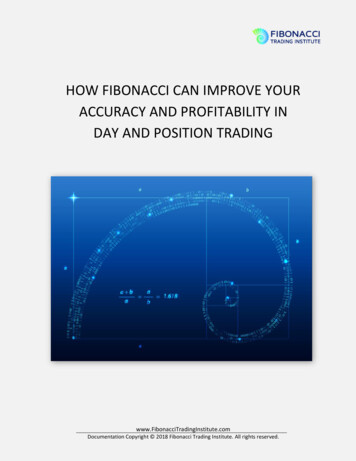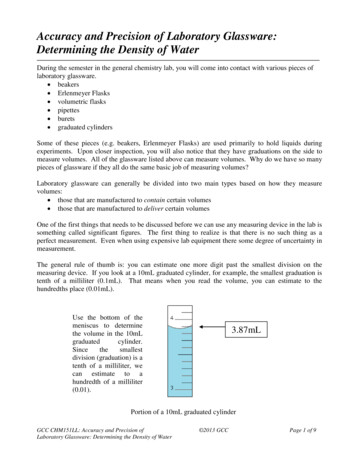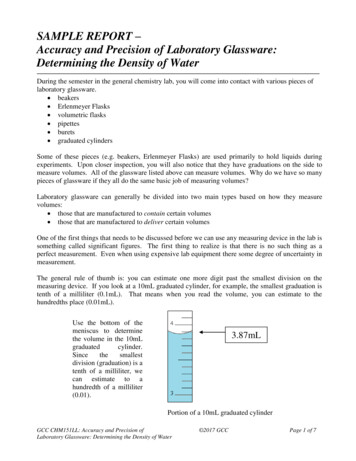
Transcription
Strategos Guide ToCycle Counting &Inventory AccuracyQuarterman Lee
Copyright NoticeCopyright 2006 Strategos, Inc.Site License EditionAs a registered purchaser of this Site License Edition, you may make multiple copies providedthat those copies are distributed only to employees located at the purchasing site. The buyer mayNOT sell or transfer the electronic file to any other division, site, individual or corporation.A personal edition of this book is available at low cost for individual purchasers. It is in an EBook format and may be viewed or printed by any computer with Microsoft Internet Explorer,Version 5.0 or higher. For more information go to www.strategosinc.com.Printing NoteThis edition is designed for printing in either color or black and white. It is formatted for lettersize 8-1/2x11 paper. It may be printed on one or both sides and inserted in a three-ring binder.The distribution file is in standard PDF format. Adobe Acrobat Reader is required for printingand is available at no cost from www.adobe.com. To open this file you will need the authorizedpassword provided at the time of purchase.Published ByStrategos, Inc.3916 WyandotteKansas City, Missouri, 64111, USAwww.strategosinc.com
Author’s PrefaceThere seems to be an aura of mystery about cycle counting in many minds. Suchmystery leads some people to over-estimate its value and view it as the panaceafor inventory ills of all sorts. In other cases, the mystery makes people reluctantto use it where, in fact, it might make a valuable contribution to operations.The mystery and subsequent misjudgments and misapplications have led tomixed results and a mixed reputation for cycle counting. The popularity of LeanManufacturing compounds any discussion with arguments that inventory shoulddisappear and therefore make cycle counting irrelevant.This small book attempts to take the mystery out of cycle counting. Part of the mystery comesfrom cycle counting’s theoretical basis in statistics. I have tried to explain this basis clearly andintuitively without the usual statistical notation and paraphernalia.However, cycle counting is not the real issue. The real issue is inventory accuracy. Cyclecounting, properly implemented and maintained, can make an important contribution toinventory accuracy when part of a larger Manufacturing Strategy. This book also attempts to putcycle counting into that larger context and present other approaches and elements of an effectiveinventory accuracy program. It attempts to clarify the role of Lean Manufacturing and how leanelements interact with inventory accuracy.I hope you find this book useful and valuable. Comments from readers are always welcome. Youmay reach me at: qlee@strategosinc.com.Quarterman Lee
ContentsAuthor’s PrefaceContentsTables1.0 Inventory Accuracy1.01 What Inventory Accuracy Is and Why It Matters1.02 How To Measure Inventory Accuracy1.03 Causes & Cures2.0 Cycle Counting2.01 Introduction To Cycle Counting2.02 Why Cycle Counting works2.03 Designing The Program2.04 Selection Methods2.05 Improving Effectiveness2.06 Estimating Resources2.07 Timing And Interference With Operations2.08 Cycle Counting Implementation3.0 Physical Inventories3.01 The Annual Inventory3.02 Conducting A Successful Audit3.03 Cards, Count Sheets, Barcodes3.04 Staffing For The Physical Inventory4.0 Process Improvement4.01 Prevention Versus Correction4.02 Root Causes of Inventory Errors4.03 Process Improvement Example4.04 Theft & Shrinkage5.0 Reducing Transaction Volume5.01 The Drivers of High Transaction Volume5.02 Techniques For Transaction Reduction5.03 Transaction Reduction Example6.0 Strategies For Inventory Accuracy6.01 Introduction6.02 Combining PI and Cycle Counting For Error Correction6.03 Error Prevention6.04 Organizing the Implementation Project6.05 A Final WordAbout The AuthorAppendicesAPP2-Kanban SystemsAppendix 1 Confidence Belt ChartsAppendix 2 Random Selection From A DatabaseKanban Scheduling 34748484952595959616263646565666971
FiguresFigure 1 Physical Count and Records AgreeFigure 2 ABC ClassificationFigure 3 Inventory Error & Transaction RatesFigure 4 Cycle Counting ExampleFigure 5 Statistical SamplingFigure 6 Confidence Belt ChartFigure 7 Using Confidence BeltsFigure 8 Count Rate & Improvement SpeedFigure 9 Effects of Error CreationFigure 10 Effects of Database SizeFigure 11 Estimator Output ChartFigure 12 ABC Output, Example AFigure 13 IRA With Physical InventoryFigure 14 Example Physical Inventory Project PlanFigure 15 General Task Sequence for Count SheetsFigure 16 Typical Count SheetFigure 17 General Task Sequence for Inventory TagsFigure 18 Examples of Inventory TagsFigure 19 Physical Inventory Temporary Organization StructureFigure 20 Generalized Inventory Error CausesFigure 21 Preliminary Error CharacteristicsFigure 22 Over-Count Fishbone DiagramFigure 23 Functional Layout Material FlowFigure 24 Cellular Layout Material FlowFigure 25 Peristaltic Pump AssemblyFigure 26 Original Peristaltic Pump BOMFigure 27 Simplified Peristaltic Pump BOMFigure 28 Original Casting Process With Transaction PointsFigure 29 Process With Kanban SchedulingFigure 30 Process With Cellular Layout For MachiningFigure 31 With Cellular Layout, Kanban and BackflushingFigure 32 Extending Kanban and Point-Of-Use Delivery To SupplierFigure 33 IRA With Physical Inventory & Cycle CountingFigure 34 Example A Using PI and Cycle 5484950515153545556576061
TablesTable 1 ABC Percentages & ExamplesTable 2 Typical Count TolerancesTable 3 Inventory Calculation ExampleTable 4 Typical ABC Count FrequenciesTable 5 Example "A" ABC EstimatingTable 6 Estimator Data Inputs, Example ATable 7 ABC Input Data, Example ATable 8 Partial Cycle Count Error LogTable 9 Comparison of Functional & Cellular LayoutsTable 10 Process Map SymbolsTable 11 Input Data, Example A With Initial Physical Inventory1112132223242544505260
Chapter1.0 Inventory AccuracyThis first chapter defines Inventory Accuracy and, explains why it is an important issuefor any business that holds significant inventories. Inventory is a central theme of LeanManufacturing, Lean Warehousing and Lean operations and here we explain howInventory Accuracy fits into these Operations Strategies.The chapter describes how to measure accuracy and addresses the question of “Howaccurate is accurate?” It introduces the two important methods for correcting inventoryerrors, Physical Inventories and Cycle Counting. And, finally, we introduce the rootcauses of inaccuracy and how to eliminate or minimize them.1.01 What Inventory Accuracy Is and Why It MattersWhat Is Inventory Record Accuracy?Inventory Record Accuracy (IRA) is a measure of how closely official inventory records matchthe physical inventory (figure 1). Many managers equate IRA with cycle counting, but there is alot more to it than just counting.PhysicalCountRecordFigure 1 Physical Count and Records AgreeThe units of measurement are either dollar based or count based. These two bases have differentpurposes and may give widely differing results.Accountants and financial auditors prefer dollar-based measurements of accuracy. Their concernis to ensure that the inventory value stated on books and tax returns is accurate at an aggregatelevel. Discrepancies on individual items hold little concern provided that positive and negativediscrepancies are roughly equal and the total value is the same. Operations and materialmanagement people have a stronger interest in the accuracy of individual SKUs. If one SKU isshort, they can rarely substitute some other part or item that happens to be long. They need countbased measurements of accuracy.
Why Inventory Accuracy Is ImportantThe reasons for having accurate records are legion. Stockouts increase cost in a hundred waysand sap the time and energy of everyone. Poor accuracy begets more inventory and requiresmore capital. Inventory is often the largest consumer of capital for an enterprise. The variousreasons for accuracy fall into the two general categories of financial and operational. Here are afew of them:Financial Reasons: Investors want to know that the book value is accurate and inventory isusually a large balance sheet item. Combined with other financial data into various ratios, imventory is aprimary indicator of a company’s financial health and value. Conventional lenders, such as banks, often lend money using inventory ascollateral. If the loan should default, they want to ensure that the inventory stated is accurate.They are also likely to be concerned about obsolete and slow moving inventory. Taxation often depends on inventory value. Overpayment of taxes reduces profits andunderpayment incurs penalties.Operational Reasons: Stockouts interrupt production and create delivery delays. Missing items cause delays and idle time that reducemanufacturing efficiency. Schedules must often be juggled to accommodatestockouts. People waste hours looking for misplaced or missingitems. This happens in the warehouse and often again on themanufacturing floor. When stockouts are frequent, inventory rises to compensate. This unnecessary inventoryrequires space and capital. Inventory turnover reflects overall manufacturing efficacy. MRP and ERP systems require very high accuracies (95%-99%) to function well. The annual physical inventory audit is a nuisance for everyone and takes several days fromproduction capacity. Such audits are required when inventory accuracy is questionable but can beeliminated when accuracy is demonstrated to the auditors through cycle counting and othermeans.
IRA and Lean OperationsInventory accuracy links to Lean Manufacturing in much the same way that quality is linked toLean Manufacturing. They both eliminate waste and allow the smooth production with lowinventories that characterizes lean. In fact, inventory accuracy is really a special case of quality;it is quality in the warehouse and transaction process.Lean ManufacturingLean Manufacturing reduces the need for inventory and transaction volume in manyways. It makes high accuracy easier. If transaction volume is reduced through kanban,backflushing, Cellular Manufacturing or other simplification, errors drop proportionately.The stockouts common to firms with poor accuracy generate significant fears throughoutthe organization and create difficulties for a lean implementation. Because of this,increasing inventory accuracy through more conventional means such as cycle countingmay be a necessary part of a lean implementation.The Lean WarehouseIRA is also an element of lean operations within the warehouse. Inaccurate records areone of the major sources of waste for warehouse and inventory operations. At he sametime, streamlined warehouse processes and low inventory prevent many errors fromoccurring.The Lean OfficeThe lean office takes Lean Manufacturing principles and applies them to the typicaladministrative and information-based activities of office work. Since inventory accuracydepends greatly on information-based transaction processes, lean office techniques applydirectly. At the same time, increased inventory record accuracy helps smooth many frontoffice processes that depend on inventory information.1.02 How To Measure Inventory AccuracyA Question of QualityInventory Record Accuracy is a quality issue. All the methods, principles, thinking andphilosophy of Total Quality Management (TQM) and Six Sigma apply. The work process is theprocess of conducting transactions, storing material and moving material. The product is anaccurate inventory record. Our customers are the users of these records, primarily scheduling,sales and operations people who depend on their accuracy.Foremost among the principles and philosophies is the concept of prevention versus detection.Prevention of errors is the key and most important approach. Detection and correction areinferior stopgap measures to be used only until proper preventive measures can be put into effect.
ABC & TolerancesThe Value of ClassificationABC classification and stratification is a common method for ranking the relative importance ofinventory items. The most important items (A-Items) get counted more often and have moreexacting count tolerances.All items in an inventory database rarely need the same degree of accuracy. A manufacturer ofindustrial vehicles might need 100% IRA on their stock of engines, for example. Engines costupward of 4000.00 each, occupy significant warehouse space and have a five-week deliverytime. Their stock of ¼” flat washers, however, cost only about 0.002 each, requires minimalspace and they are available at the local hardware store. Cycle counting washers with the samefrequency and rigor as required for engines would cost more than the washers themselves.ABC classification is usually based on the value of the annual usage of each item. Item usagevalues follow Pareto’s principle with a few high value items and many low value items. Figure 2illustrates this with a typical Product-Volume chart. However, judgment should also be used.Some items may have a low usage value but they are critical to operations and may have createddifficulties in the past. Table 1 shows the typical range of percentages along with examples.Some companies extend this idea and add an “A ” category or a “D” category.ABC classification is fundamental to any inventory strategy. It helps direct resources to thoseareas and items that have the most impact on operations and finance.
ABC Classification3000280026002400A n n u a l U s a g eV a lu e2200A10%20001800160014001200B20%1000800600C 70%4002000Class% ofSKUsExamplesA 1%Very High Value—diamonds, CPU chips, engines,complex products. Often kept in security cage.A5%-15%High Value/Critical Items—hydraulic valves,custom-made components.B20%-30%Medium Value—ball valves, raw steel, aluminumingots, pulleys, standard machine components.C65%-75%Low Value/Readily Available/Bulk—hardware,copy paper, etc. Often use weigh counting.D 2%Consumables—shop rags, paper clips, soap, etc.Do not carry as inventory.Table 1 ABC Percentages & Examples70900-1Figure 2 ABC 62971797-T721137131671650-T823156070862594Part #
TolerancesIt is not unrealistic to expect that the physical count and recordwill exactly match for every item; nor is it practical. Aninventory record should be considered accurate if it matches thephysical count within a reasonable tolerance. Most often, counttolerances are based on the ABC classification and typicaltolerances are in table 2. There may be occasional exceptions tothese tolerances.Table 2 Typical Count TolerancesCalculating AccuracyThe actual calculation of inventory accuracy is quit simple. It isthe percentage of items having accurate records. The formula is:IRA (%) Number of Correct RecordsNumber of Records CheckedClassTypicalTolerancesA ( /-) 0%A( /-) 0%-1%B( /-) 3%-5%C( /-) 10%-15%DN/AX 100The formula applies to inventory as a whole and also to each class (ABC) within the database.You can use it to calculate accuracy for a day’s cycle counting, or the annual physical audit.To count as accurate, a record should meet three criteria:1. The quantity on record must match the physical count within the tolerance for that item.2. The location on record must match the physical location.3. The item should have no outstanding transactions.Criterion three is sometimes a serious difficulty. In some organizations transactions take place(e.g. an item is received). But the transaction is not entered into the computer system or postedfor hours, days or weeks. From a financial standpoint, such posting delays make no difference.From an operational standpoint, however, it is critical. Un-posted transactions create a lot ofchaos. The author has spent many hours searching for parts that exist physically but theirtransaction was simply not posted.Table 3 shows a sample of 13 items that were physically counted. It contains the physical count,the record quantity and the percentage difference. The tolerance limits are based upon the ABCclass. Columns on the right indicate whether this item meets each of the three tests for anaccurate record: count, location and transaction posting. Nine records pass all three tests. TheIRA calculation is, therefore, (9/13 x 100) 69.2%.
cal Inventory Quantity%CountRecord Difference -1-0.2%444137.3%Tolerance%Part YYNNYYYNYYYYYYYY9Count IRA 69.2%Table 3 Inventory Calculation Example1.03 Causes & CuresReasons For InaccuracyThere are many causes for inaccurate records. People may enter data inaccurately or not at all.Confusing location codes cause discrepancies between recorded and actual locations.Occasionally, software bugs introduce errors. The thousands of possible causes are eitherprocess-related or volume-related.Process Related Errors— Each step in a transaction process introduces some probability forerror, even if that probability is small. To reduce process-related errors, we must change theprocess.Volume-Related Errors— Every transaction process has an inherent error rate or probability oferror resulting from the structure and execution of the process. Over time, and with manytransactions, the number of new errors per week or per thousand transactions is relativelyconstant, if the process remains unchanged. The more transactions; the more errors.Methods To Improve AccuracyTo improve inventory record accuracy, the error creation rate (i.e. errors per week, month, etc.)must be less than the error removal rate. To increase accuracy we can either decrease errorsflowing in or increase the removal rate. Figure 3 illustrates.Methods to improve accuracy include Cycle Counting, Physical Inventory, TransactionReduction and Process Improvement. Cycle counting and the physical inventory remove errors.Process improvement and transaction reduction prevents new errors. An optimal approach toInventory Record Accuracy uses both.
Transactions &Errors InErrorsOutCurrent InventoryRecordsTransactionsOutCurrent ErrorsFigure 3 Inventory Error & Transaction RatesBelow is a thumbnail summary of the four methods. Subsequent chapters elaborate on each ofthese methods and how to combine them into a comprehensive and effective inventory accuracyprogram that will enhance your Lean Manufacturing or other manufacturing strategy.Physical InventoryIn a physical inventory, normal operations cease while a physical count of every item isconducted. The counts are compared to inventory records and, when necessary, the records arecorrected.Cycle CountingA small number of items are physically counted, daily, on a random or semi-random basis. Thephysical count is compared to the inventory record. When necessary, the records are corrected.Process ImprovementProcess Improvement examines the transaction processes. Changes are identified andimplemented that reduce the probability of error.Transaction ReductionThe most effective way to reduce errors is to reduce the number of transactions. Fewertransactions introduce fewer errors. Kanban, BOM simplification, cellular manufacturing andother elements of Lean make this feasible.
for any business that holds significant inventories. Inventory is a central theme of Lean Manufacturing, Lean Warehousing and Lean operations and here we explain how Inventory Accuracy fits into these Operations Strategies. The chapter describes how to measure accuracy and addresses the question of
